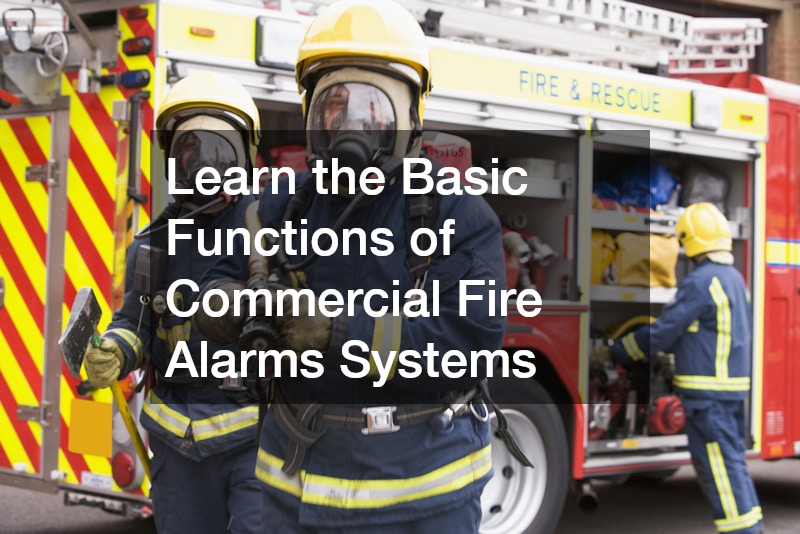It’s important to have a comprehensive overview of the basic functions of commercial fire alarms systems and understand common questions and inquiries related to their operation, components, and importance in safety.
Primary Components
The control panel serves as the brain of the fire alarm system, processing signals from various components and determining the appropriate response. It plays a crucial role in monitoring the health of the system and sending alerts when necessary.
Additionally, control panels often come equipped with features that allow for remote monitoring.
Detection devices are critical as they are responsible for identifying signs of fire, such as smoke or heat. These devices can include various technologies, each designed for specific environments and types of fires. Their reliability affects the overall performance and safety of the fire alarm system.
Alarm notification appliances are the devices that alert occupants of a potential fire. Common examples include sirens, horns, and flashing lights. These devices are designed to be heard and seen clearly, ensuring that all building occupants are alerted promptly in the event of a fire. They are essential for a well-functioning fire alarm system.
Smoke and Heat Detection
Photoelectric smoke detectors work by utilizing a light beam and a sensor to identify smoke particles in the air. This type of detector is particularly effective in detecting smoldering fires, which produce a lot of smoke but little heat. Their sensitivity makes them suitable for places where a rapid response is crucial.
Ionization smoke detectors, on the other hand, use radioactive material to ionize air in the sensing chamber. This creates a current that is disrupted when smoke enters the chamber, triggering the alarm. Ionization detectors are usually more responsive to fast-flaming fires, making them complementary to photoelectric detectors in various commercial settings.
Heat detectors add another layer of safety by monitoring changes in temperature. They are ideal for areas where smoke detectors may produce false alarms, such as kitchens. By detecting a rapid rise in temperature or a specific threshold, heat detectors contribute significantly to comprehensive fire safety measures within commercial environments.
Notification Types
Horns and sirens play a vital role in alerting occupants during a fire emergency. They are designed to produce loud sounds to ensure that the alarm is heard above the noise of machinery or background chatter. The effectiveness of these auditory alerts is key to quickly informing everyone in a building of potential danger.
Strobe lights are often used alongside auditory alerts to cater to people with hearing impairments. Flashing lights can grab attention and signal the need for immediate action. In larger facilities, these visual alarms can be especially important for drawing attention to multiple areas that may be at risk.
Intercom systems are also invaluable in commercial fire alarm systems, as they can provide real-time instructions from authorities during an emergency. This allows for effective communication, ensuring that occupants know whether to evacuate or shelter in place. Effective communication can save lives in emergency situations, making these systems critical components.
Emergency Services Connection
Many modern commercial fire alarm systems incorporate features that allow for automatic notification to local fire departments when an alarm is triggered. This connection is made possible through dedicated phone lines or cellular connections, ensuring swift communication during emergencies.
Having a direct link to emergency services significantly enhances response times, which is crucial in potential fire incidents. Rapid action can help minimize damage to property and prevent loss of life. This feature is particularly essential in high-risk environments where the danger of fire escalation is greater.
Additionally, detailed information about the alarm location and system can be transmitted to emergency responders, improving their preparedness upon arrival. This means that firefighters will know exactly where to go and what to expect, aiding in a more effective and efficient response to the situation.
Maintenance Requirements
Regular inspections are crucial for the reliability of fire alarm systems. These inspections should be conducted at least annually, although semi-annual checks may be mandated by local fire codes. Inspection services typically assess the functionality of detectors, troubleshoot any problems, and ensure compliance with all relevant regulations.
Testing procedures serve to validate that the system is functioning correctly and can alert occupants in the event of a fire. This may include testing the control panel, activation of alarm devices, and checking the operation of emergency communication systems. Frequent testing helps identify any issues before they can jeopardize safety, enhancing overall preparedness.
Compliance with fire codes is essential for both legal and safety reasons. Businesses must stay informed about local fire safety regulations to ensure their fire alarm systems meet all requirements. Noncompliance can result in penalties and, more importantly, increased risk to personnel, making adherence a top priority for any commercial establishment.
Understanding the basic functions of commercial fire alarm systems is essential for maintaining safety in any business environment. Regular updates and education on these systems can significantly enhance emergency preparedness and response.

